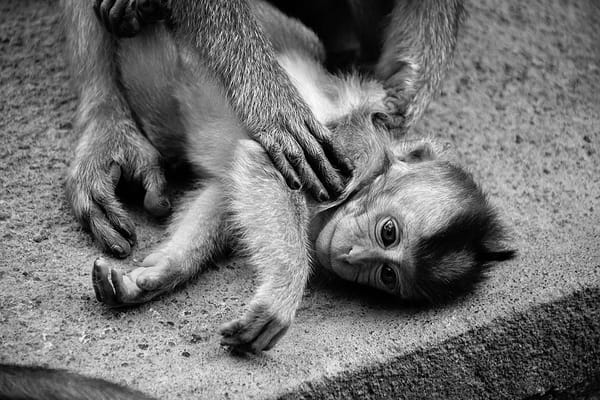Harry Harlow's Baby Monkey Experiment
Experiments like the ones which Harlow performed with baby Rhesus monkeys helped to reveal that the same underlying mechanics of attachment in mammals are also at work in the infantile development of humans.

My research on the self, as well as my experience of bonding with my son this year, has prompted for me more sustained reflection on human attachment lately. Harry Harlow's experiment with baby Rhesus monkeys in the 1960's remains a touchstone in the field, so I've decided to provide readers with a brief introduction to Harlow's experiments and their findings.
Attachment and Co-Sleeping
My wife and I have slept with our son in our bed from the very first night we brought him home from the hospital. While this used to be the norm for families historically (and is still the norm for most families outside the United States), it's become taboo today, and is highly discouraged by the medical establishment.
What could be the societal effect of generations of children sleeping alone at night? We likely can't know for sure. Infants wake regularly, as their sleep cycles are much shorter and lighter than an adult's, and thus infants and children throughout our nation awake alone in a dark room multiple times every night, often left to cry it out until they go back to sleep.
Experiments like the ones which Harlow performed with baby Rhesus monkeys helped to reveal that the same underlying mechanics of attachment in mammals are also at work in the infantile development of humans. Among other things, Harlow showed that, to the child, the mother's provision of comfort and emotional regulation actually supersedes the importance of the delivery of milk.
Physical contact, which directly impacts an infant's biological development and psychological regulation, is the single most important thing a child can receive from their caretakers, just like for Harlow's baby monkeys.
What was Harry Harlow's experiment with the baby Rhesus monkeys?
Harry Harlow was a scientist at the University of Madison-Wisconsin, who infamously performed research with baby Rhesus monkeys during the 1960's. His experiments broke new ground in their demonstration of the primacy that feelings like comfort and security have in both the physical and psychological development of mammals, findings which he also argued were transferable to our understanding of humans.
Monkeys raised in wire cages
The most infamous of Harlow's experiments was the maternal deprivation experiment. While this experiment yielded astounding results, the experiment would likely never be able to be replicated today in a laboratory due to the ethical issues at play in depriving baby monkeys of their mothers. The experiment has continued to draw criticisms to this day.
For this experiment, Harlow raised baby Rhesus monkeys in wire cages without any contact with a mother and with no opportunities to physically contact their peers in other cages. These isolated monkeys developed psychological impairments such as compulsive or repetitive behaviors, and significant difficulty forming friendship or sexual relationships.
Monkeys raised in complete isolation
Harlow then decided to push the experiment even further by designing an enclosed environment in which a monkey would be raised for either 3, 6, or 12 months in complete isolation from any human or monkey contact.
What he reports combines notes of despair and hope – on the one hand, two of the six monkeys removed from total isolation after 3 months were so shocked that they refused to eat, and one of them even died. While none of the monkeys died in isolation, they exhibited extremely nervous and autistic behaviors (clutching themselves, huddling in corners) when they first emerged from isolation.
However, on the other hand Harlow also documents that his team could not identify any long term negative effects for the group who were brought back into a social group after 3 months. It seems that these babies were able to re-socialize and develop in a comparable way to their peers. This speaks to the adaptability of mammals if they can be re-integrated into the group soon enough.
The story is different though for those who stayed in the isolation chambers for 6 to 12 months. For those who were isolated for the first 6 months of their life, they showed little to no desire to engage with their peers once they brought back into the social group, and they certainly engaged in almost no play whatsoever.
Things were even more dismal for those who had been isolated for the first 12 months of their life. These monkeys did not engage in any play or social interaction, but were rather exhibited a constant state of fear at the presence of others. They were not aggressive, but simply terrified and unwilling to engage socially. They also showed no interest in sex or mating, not even engaging in any auto-erotic behavior which all the other groups occasionally displayed.
Monkeys raised with cloth mothers and wire mothers
From these experiments in isolation and re-socialization, Harlow derived three more experiments which were intended to understand the effect that the presence of a caretaker might have on the development of the baby monkey --
- Monkey is raised by a wire mother with milk and a cloth mother with no milk
- Monkey responds to a frightening scenario
- Monkey copes with an unfamiliar environment
The video below captures footage of Harry Harlow demonstrating in real time these three experiments for a reporter. You can watch the video, or read my description below.
For these experiments, the monkey’s are provided with two mothers — one cloth and one wire. The wire mother is given the milk bottle, and thus the wire mother is the one that weans the baby monkey from the time that they are born. The cloth mother never provides them with milk at any point.
However, Harlow found that the baby monkeys would get their milk as quickly as they could from the wire mother, and then spend their entire day on the cloth mother. In the video above, Harlow tells the reporter that the baby monkeys spend 17-18 hours a day on the cloth mother, and less than an hour a day on the wire mother.
When they are frightened, the baby monkeys flee straight into the cloth mothers arms. Upon contact with the mother, the monkey’s fear begins to visibly disappear, and eventually, they will take to vocalizing back at the threat in an attempt to scare it away — all from the security of the cloth mother’s lap.
When put into a new situation or foreign environment, the baby monkey instinctively searches for comfort and security. If there is none, the monkey curls up into a ball, clinging to the softest thing it can find. When researchers place the wire mother in the new space, the monkey does not approach it for comfort at all, even though it was nursed its entire life by this wire mother.
However, when the scientists put a cloth mother in the space, the monkey runs straight to her, clinging to her, pressing all of its body against her. Again, we can watch as this little monkey’s whole body relaxes, it slowly begins to survey its surroundings, and eventually, it separates from the mother to go explore and interact with this brand new environment in which it finds itself.
Harlow's Behaviorism
Harry Harlow was one amongst a number of scientists in the early and mid-twentieth century who were occupied with the question of infants and human development. One thing that Harlow and these others wanted was to give a larger role to things like comfort and security in the development of humans, not simply seeing physical sustenance and sleep as the primary motivating factors for humans.
However, like many psychological researchers of his time, Harlow also operated with a behaviorist model, meaning that he tried to focus exclusively on what could be observed, especially the connection between stimuli and behaviors, rather than attempting to theorize about invisible mental phenomena like inner states and motivations.
We can see this come out in his interesting little piece "The Nature of Love" (linked below) where he observes how, while psychoanalysts had investigated the human oral drive to suckle at the breast, "there exists no direct experimental analysis of the relative importance of the stimulus variables determining the affectional or love responses in the neonatal and infant primate [emphasis added]. Harlow is thus concerned with the specific behaviors, qualities, and situations which make up the child's "love response," not the internal state of feeling loved or loving.
While many today view the behaviorist model as a dead-end and inadequate in its ability to explain the psychology of humans (I count myself amongst its critics), it was the reigning paradigm for decades (especially in America), and it produced fascinating research through its relentless drive to observe what creatures do rather than what they say about what they feel. Harlow's experiments, as controversial as they are, produced valuable insight into the situation of mammals like ourselves who are utterly dependent on this phenomenon called attachment.
Further resources
Harlow's Classic Studies Revealed the Importance of Maternal Contact
"Total Isolation in Monkeys" by Harry F. Harlow, Robert O. Dodsworth, and Margaret K. Harlow.
"The Nature of Love" by Harry F. Harlow
Harry Harlow on Wikipedia
In case you missed it, a new episode of Samsara Audio was released this week! I sat down with my friend Minnow Park to delve into some raw conversation about our experience growing up in the Presbyterian church and wrestling with some intellectual questions which have arisen for us as we've grown older. This was a hard-hitting conversation, so I highly recommend checking it out on the podcast app of your choosing.
Note that Samsara Audio was recently moved to Substack so I could manage those posts and messaging separately from Samsara Diagnostics. If you are currently subscribed to this newsletter, there is no action required on your part to start receiving those notifications.
Thanks for taking the time to read Samsara Diagnostics this week. Whether you're a paid subscriber or not, I want you to know that I'm thankful for the chance to share my work with you. Please email me if you'd like to share any comments or feedback about how I can serve you better.

